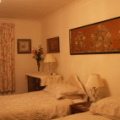
|
|||||

Gallery 54 - Ross on..
 Contemporary abstract art, ceramics and glassware Contemporary abstract art, ceramics and glassware
Hippo The Watersaver
 is the simple, proven and low cost water saving device to help conserve water i.. is the simple, proven and low cost water saving device to help conserve water i..
Life Changing Activi..
 Fun, adventure, and personal growth in the Great Outdoors Fun, adventure, and personal growth in the Great Outdoors
|
Flaxley

Today Flaxley offers a pleasant picturesque wooded scene and is difficult to imagine it any other way, but it has a strong industrial past, notably of iron furnaces, forges and water mills. The earliest known forge was present as early as 1150 and at least five mills have been identified as utilising the waters of Westbury Brook which runs down the valley. The earliest and most famous industrial site is Guns Mill, (at SO67519), now a luxurious guesthouse. This blast furnace, was built by Sir John Wintour, operated between 1629 to 1743 and was named after William Gunne, the owner of an earlier mill on the site. Guns Mill was used primarily for armament production and in 1629, the Crown ordered that 610 guns were to be made there and sent to Holland, but many were subsequently used by both sides in the English Civil War. The furnace was destroyed by order of Parliament in 1650 but it was rebuilt in 1683 and remained in use until c1743 when it became a paper mill. The latter closed in 1879 but several of the furnace's buildings remain and the site is now a scheduled monument as it is the finest remaining example of a charcoal blast furnace from this period in the country. Flaxley is also famous for its old Cistercian abbey founded between 1148 - 1154 by Roger, Earl of Hereford, at the spot where his father, Miles of Gloucester, was killed whilst out hunting. The abbey and its monks were initially favoured by the Crown and it was granted land (by Henry II in 1158) as well as timber and woodlands (by Henry III in 1227) The abbey survived as a monastic entity until the Dissolution in 1536 - 7 when its lands and manor were granted to Sir William Kingston, the Constable of the Tower of London (who supervised the execution of Ann Boleyn). The present Church of St Mary, with its contrasting red and grey Forest stone, was built in 1856, it has a richly decorated interior and a very elaborate font made of Painswick (Cotswold) stone with marble columns on octagonal steps. Lying just west of Flaxley in Welshbury Woods, it Welshbury Hill-fort. This Iron Age hill fort has impressive triple defensive rampart and ditches on its south and west sides with a single bank and ditch on the north and east and an entrance. It lies on Forestry Commission land, and is accessible to the public, it has never been evacuated but in recent years it has been damaged by forestry operations and to minimise this the Forestry commission has reverted to using hoses on the site. Two interesting archaeological finds are associated with Welshbury, firstly a Celtic electrum coin which was found in fields nearby and depicts a stag or horse and secondly, an iron spearhead of Roman military style, which was found inside the ramparts after ground disturbance due to logging. Below the north ramparts of Welshbury is the enigmatic St Anthony's Well, an ancient spring whose name dates from the medieval period. However prehistoric flint implements have been found in the springs vicinity as well as Iron Age and Roman artefacts and it seems likely that the well was a ritual site for a long period of time.
Churches
St. Mary, Flaxley, originated as a gateway chapel of a Cistercian Abbey which was founded in c1150. During the 1530's the abbey became a mansion due to the general dissolusion of the monasteries and therefore the chapel became a church. Inside, there is a monument, with cherubs, to Abraham Clark dated 1683 and tablets to the Crawley and Boevey families. The church was rebuilt in 1856 and was designed by Sir George Gilbert Scott and is red grit with forest stone dressings. The inside of the church is very richly decorated with carved hood mould stops, encaustic tiles, a fine pulpit, font and reredos carved by J Birnie Philip.
Nearby Accommodation
|
||||
|
|
|||||
